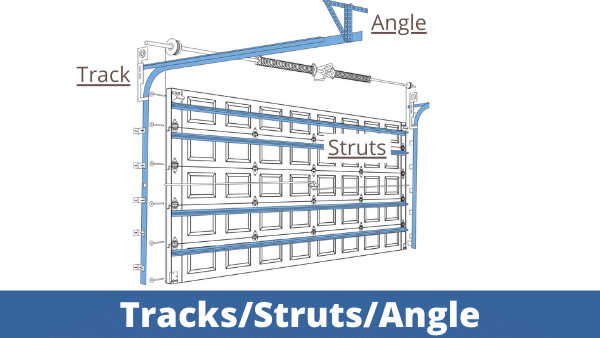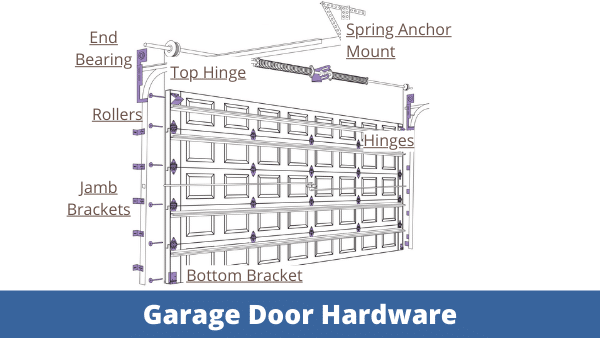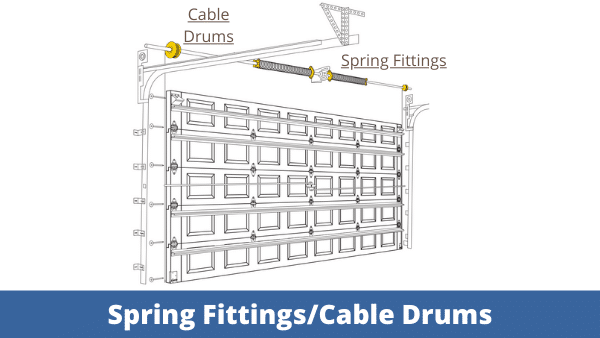
What Are The Parts of a Garage Door?
If you’re shopping for a new garage door, it’s helpful to know the parts and pieces that make garage doors work. Read more to learn about the main garage door parts. Our goal is to give you more confidence when buying garage doors.
What are the parts of a garage door?
Panels
-
Panels are the horizontal segments of a roll-up garage door. Depending on the design, you may have 4 or 5 panels on the door. It may surprise you to know that you can replace a single panel, if the sections are still in production. Panels can be hollow or built with up to 4 layers, including insulation.
Weatherstripping
-
Threshold kits repel wind driven moisture, dirt, and sand while eliminating concrete repairs. The threshold adheres to the garage floor and has an exterior angle for run-off.
-
Bottom seals are the weatherstripping secured to the bottom of your garage door. These seals come in 100’+ lengths and then cut to size and fastened to your door.
-
Door stops close off the gap between the garage door and side jamb to keep rain and dirt from coming in beside the door.
-
Brush sills are best used when you have a swing door opening onto a smooth surface. The bristles will reduce cold or hot air, but are less effective than door stops.
Springs/ Spring Components

-
Torsion springs fit around the tube shaft above the door. The tube shaft helps maintain alignment and provide buckling resistance. If a coil breaks, the broken spring will stay on the tube shaft. You may have one or two+ springs. Heat treated torsion springs come coated, galvanized, or powder coated.
-
Lifting the door with equal pull on both sides results in smooth operation. If one spring breaks, you should replace both so they have the same cycle capacity. Cycle capacity refers to the number of times your springs are rated to open/close your garage door.
Tube Shaft
-
The tube shaft is a hollow or solid steel 1″ – 1 1/4″ thick bar secured to the wall. It supports and provides resistance to the torsion springs. If a torsion spring breaks, it should remain on the tube shaft and not fly off the wall and damage something nearby.
Track/Struts/Angle

-
Like a car needs a road, your garage door needs a path to travel along. The horizontal and vertical tracks provide that for your door. Angle secures the track to the ceiling of your garage and rollers that sit inside the track channel connect to struts fixed to each section. The track is an integral part of any garage door and comes in galvanized steel. The steel is commonly fabricated using 0.051 – 0.100 gauge metal. Rolled safety edges are paramount to ensuring rollers stay in place. Track assembly and installation requires a skilled and experienced garage door technician.
Hardware

-
Garage door hardware consists of more than 10 individual pieces. These pieces work together to ensure smooth and reliable garage door operation.
-
To operate your door, hinges attached to each panel receive rollers that fit in the track. These hinges come in different gauges based on size & weight. For custom colors, you can powder coated the hinges. Top fixtures, found at the top of your door, carry the top rollers on your garage door and ensure your door seals against the header and side jambs. The top fixture can be adjusted to ensure a weather-tight seal around the jambs.
-
Note on garage door hinges. Hinges are graduated and should be in sequential order to ensure proper spacing between your garage door panels.
- Steel or nylon rollers have diameters in the range of 1.125″ – 3″. The circular end of a roller has bearings encased for a continuous smooth operation. You will often see rollers referred to using 3 numbers. For example, 2-4-10 means the roller has a 2″ diameter, 4″ length and bearing count of 10.
- Spring anchors mount in the center of the wall above the door and receive the tube shaft. These center bearing support systems are built using 8 – 11 gauge steel.
Spring Fittings / Cable Drums

-
Color-coded universal spring fittings include 1 winding and 1 stationary fitting. There are single thread spring fittings to fit left and right hand wound springs. The spring fittings are end caps placed on the right and left hand side of a torsion spring.
-
Cable drums, along with torsion springs, help garage doors remain balanced during operation. Standard-lift cable drums come in three diameters: 4″, 5-1/4″ and 8″. Each cable drum is labeled with its cable capacity embossed in the drum.
Ready to take the parts of a garage door quiz?
We’re kidding – no test or quiz here. Thanks for investing time to learn more about the parts that make your garage door work. If you have any questions or feel we missed something, please reach out and let us know.
We service garage doors and their parts. If you’re shopping for garage door items, feel free to look at our garage doors, openers, and accessories.


